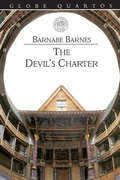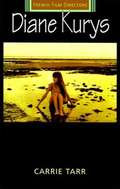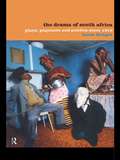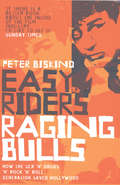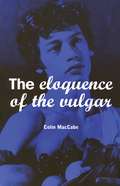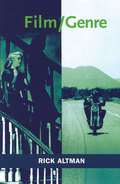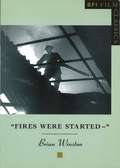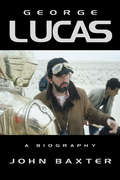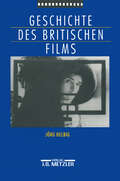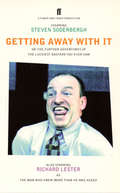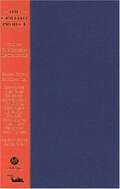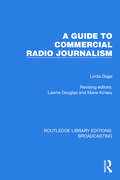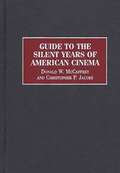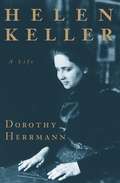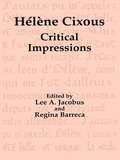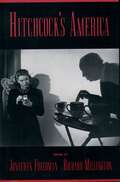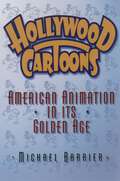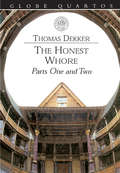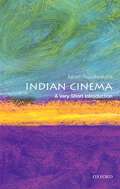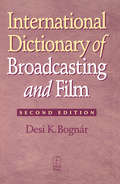- Table View
- List View
The Devil's Charter (Globe Quartos)
by Barnabe BarnesFirst Published in 1999. Routledge is an imprint of Taylor & Francis, an informa company.
The Devil's Charter: A Tragedie, Conteining The Life And Death Of Pope Alexander The Sixt (classic Reprint) (Globe Quartos)
by Barnabe BarnesFirst Published in 1999. Routledge is an imprint of Taylor & Francis, an informa company.
Diane Kurys (French Film Directors Series)
by Carrie TarrThis is the first book written on Diane Kurys. It is essential for study of women filmmakers in France/Europe. An original and concise reading of Kurys' work.
The Drama of South Africa: Plays, Pageants and Publics Since 1910
by Loren KrugerThe Drama of South Africa comprehensively chronicles the development of dramatic writing and performance from 1910, when the country came into official existence, to the advent of post-apartheid. Eminent theatre historian Loren Kruger discusses well-known figures, as well as lesser-known performers and directors who have enriched the theatre of South Africa. She also highlights the contribution of women and other minorities, concluding with a discussion of the post-apartheid character of South Africa at the end of the twentieth century.
The Drama of South Africa: Plays, Pageants and Publics Since 1910
by Loren KrugerThe Drama of South Africa comprehensively chronicles the development of dramatic writing and performance from 1910, when the country came into official existence, to the advent of post-apartheid. Eminent theatre historian Loren Kruger discusses well-known figures, as well as lesser-known performers and directors who have enriched the theatre of South Africa. She also highlights the contribution of women and other minorities, concluding with a discussion of the post-apartheid character of South Africa at the end of the twentieth century.
Easy Riders, Raging Bulls: How The Sex-drugs-and-rock 'n' Roll Generation Saved Hollywood
by Peter BiskindBased on hundreds of interviews with directors such as Coppola, Scorsese, Hopper and Spielberg, as well as producers, stars, studio executives, writers, spouses, ex-spouses, and girlfriends, this is the story of the crazy world that the directors ruled.
The Eloquence of the Vulgar: Language, Cinema and the Politics of Culture
by Colin MacCabeIn The Eloquence of the Vulgar, the distinguished academic Colin MacCabe reflects on cultural change from Shakespeare to Derek Jarman, on the institutional forms of knowledge, on the links between popular and elite art, and on the role of the intellectual in contemporary life. A radical argument emerges from the book's diverse concerns. Cinema and television - the new and democratic art forms of the twentieth century - demand a fundamental rethinking of our concepts of language and culture. What is at stake is the very idea of a liberal and humane education.
Film/Genre (Distributed For The British Film Institute Ser.)
by Rick AltmanFilm/Genre revises our notions of film genre and connects the roles played by industry critics and audiences in making and re-making genre. Altman reveals the conflicting stakes for which the genre game has been played and recognises that the term 'genre' has different meanings for different groups, basing his new genre theory on the uneasy competitive yet complimentary relationship among genre users and discussing a huge range of films from The Great Train Robbery to Star Wars and from The Jazz Singer to The Player.
Fires Were Started – (BFI Film Classics)
by Brian WinstonHumphrey Jennings (1907-50) was perhaps the most gifted film-maker of the British documentary movement. Involved in the Mass Observation project of the 1930s, Jennings' talent lay in picturing ordinary life in ways that were inventive yet authentic. "Fires Were Started –" (1943) is his major achievement. A film about a day's work for a unit of mainly auxiliary volunteer firemen at the height of the blitz, it blends observation with reconstruction to achieve a particularly poignant kind of propaganda. Lindsay Anderson expressed the opinion of many commentators and viewers when he wrote in Sight and Sound (in a 1954 article reprinted as an appendix to this volume) that Jennings was 'the only real poet the British cinema has yet produced'. But how could a documentarist also be a 'poet'?This is one of the questions addressed by Brian Winston in his study of "Fires Were Started –", a question which is particularly relevant today in the wake of the massive public controversies surrounding 'faked' documentaries. For Winston documentary film-making is always 'creatively treated actuality' and must be taken as such if it's to be properly valued and understood.
George Lucas (Text Only Edition): A Biography (text Only Edition)
by John BaxterThe first major biography (since 1983) of the great movie mogul George Lucas, whose marketing techniques have transformed the film business. His fourth Star Wars film, The Phantom Menace, released in 1999, was perhaps the most eagerly awaited cinematic event of all time.
Geschichte des britischen Films
by Jörg HelbigDie Britische Filmindustrie im Überblick. Die Geschichte des britischen Films bietet eine umfassende Darstellung der Entwicklung des britischen Spielfilms von den Anfängen in der Stummfilmzeit bis zu den Produktionen der 90er Jahre wie z.B. "Vier Hochzeiten und ein Todesfall" oder "Trainspotting".
Getting Away With It: Or The Further Adventures Of The Luckiest Bastard You Ever Saw
by Steven SoderberghSteven Soderbergh and Richard Lester are a generation apart, but theyshare a sense of humour and a passion for cinema. Soderbergh's freshman film, sex, lies and videotape, inaugurated a movementin US independent cinema. Lester's freewheeling work in the '60s and '70s (Help!, A Hard Day's Night, The Knack, How I Won the War, Petulia) helped create a 'new wave' of British film-making. Here, the two cineastes discuss their mutual passion for the medium in a frank,funny and free-ranging series of interviews. Also included is Soderbergh's diary of an extraordinary twelve months in which he ventured into 'guerilla film-making' with offbeatprojects Schizopolis and Gray's Anatomy, before returning to the Hollywood fray with the George Clooney hit Out of Sight.
The Griffith Project, Volume 3: Films Produced in July - December 1909
by Paolo Cherchi UsaiNo other silent film director has been so extensively studied as D. W. Griffith. However, only a small group of his more than 500 films has been the subject of a systematic analysis and the vast majority of his other works stills await proper examination. For the first time in film studies, the complete creative output of Griffith - from Professional Jealousy (1907) to The Struggle (1931) - will be explored in this multi-volume collection of contributions from an international team of leading scholars in the field. Created as a companion to the on-going retrospective held by the Pordenone Silent Film Festival, The Griffith Project is an indispensable guide to the work of a crucial figure in the arts of the nineteenth century.
A Guide to Commercial Radio Journalism (Routledge Library Editions: Broadcasting #2)
by Linda GageA Guide to Commercial Radio Journalism (1999) covers every aspect of the profession, from journalistic practice to media law, and gives detailed instruction on the techniques of editing and using equipment and on the basic skills of writing, reporting and producing. There is also a whole chapter dedicated to advice on court reporting.
A Guide to Commercial Radio Journalism (Routledge Library Editions: Broadcasting #2)
by Linda GageA Guide to Commercial Radio Journalism (1999) covers every aspect of the profession, from journalistic practice to media law, and gives detailed instruction on the techniques of editing and using equipment and on the basic skills of writing, reporting and producing. There is also a whole chapter dedicated to advice on court reporting.
Guide to the Silent Years of American Cinema (Reference Guides to the World's Cinema)
by Christophe P. Jacobs Donald McCaffreyThe latest offering from the Reference Guides to the World's Cinema series, this critical survey of key films, actors, directors, and screenwriters during the silent era of the American cinema offers a broad-ranging portrait of the motion picture production of silent film. Detailed but concise alphabetical entries include over 100 film titles and 150 personnel. An introductory chapter explores the early growth of the new silent medium while the final chapter of this encyclopedic study examines the sophistication of the silent cinema. These two chapters outline film history from its beginnings until the perfection of synchronized sound, and reflect upon the themes and techniques established with the silent cinema that continued into the sound era through modern times.The annotated entries, alphabetically arranged by film title or personnel, include brief bibliographies and filmographies. An appendix lists secondary but important movies and their creators. Film and popular culture scholars will appreciate the vast amount of information that has been culled from various sources and that builds upon the increased studies and research of the past ten years.
Helen Keller: A Life
by Dorothy HerrmannDorothy Herrmann's powerful biography of Helen Keller tells the whole story of the controversial and turbulent relationship between Helen and her teacher, Annie Sullivan. Herrmann also chronicles Helen's doomed love affair, her struggles to earn a living, her triumphs at Radcliffe College, and her work as an advocate for the disabled. Helen Keller has been venerated as a saint or damned as a fraud, but Herrmann shows her to have been a beautiful, intelligent, high-strung, and passionate woman whose life was transformed not only by her disabilities but also by the remarkable people on whose help and friendship she relied. "Fascinating. . . . Stripping away decades of well-meaning sentimentality, Herrmann presents a pair of strong-willed women, who struggled to build their own lives while never forgetting their dependence on each other."—Ron Charles, Christian Science Monitor "We meet an entirely unexpected Helen Keller—a woman with deep if concealed ambivalence toward her self-sacrificing teacher; a political radical; and a woman longing for romantic love and the fulfilled sexual life of a woman."—Joan Mellen, Philadelphia Inquirer "Herrmann's portrait of Keller is both fully embodied and unflinchingly candid."—Mary Loeffelholz, Boston Sunday Globe "This well-proportioned biography of the deaf and blind girl who became a great American crusader rescues its subject from the shackles of sainthood without destroying her as an American hero."—Dennis Drabelle, Cleveland Plain Dealer "Herrmann's engrossing biography helps us see beyond the public's fascination with how Keller dealt with her disabilities to discover the woman Keller strived to be."—Nancy Seidman, Atlanta Journal-Constitution "Perhaps the most intimate biography [of Helen Keller]. [Herrmann] gives her back her sexuality [and] imbues her with a true humanity. . . . Helen Keller: A Life has some of the texture and the dramatic arc of a good novel."—Dinitia Smith, New York Times
Hélène Cixous: Critical Impressions
by Lee A. Jacobus Regina BarrecaFirst published in 1999. Routledge is an imprint of Taylor & Francis, an informa company.
Hélène Cixous: Critical Impressions
by Lee A. Jacobus Regina BarrecaFirst published in 1999. Routledge is an imprint of Taylor & Francis, an informa company.
Hitchcock's America
by Jonathan Freedman, Richard MillingtonAlfred Hitchcock's American films are not only among the most admired works in world cinema, they also offer some of our most acute responses to the changing shape of American society in the 1940s, 50s, and 60s. The authors of this anthology show how famous films such as Strangers on a Train, Vertigo, North by Northwest, and Rear Window, along with more obscure ones such as Rope, The Wrong Man, and Family Plot, register the ideologies and insurgencies, the normative assumptions and the cultural alternatives, that shaped these tumultuous decades. They argue that, just as these films occupy a visual landscape defined by the grand monuments of American civic life--Mt. Rushmore, the Statue of Liberty, the United Nations--they are also marked by their preoccupation with the social mores and private practices of mid-century America. Not only are big-city and suburban life the explicit subjects of films like Rear Window and Shadow of a Doubt, so are the forms of experience that emerge within these social spaces, whether the urban voyeurism examined by the former or the intertwining of banality and violence depicted in the latter. Indeed, just about every form of American life that was achieving social power at this time--the national security state; the science and art of psychoanalysis; the privileging of the free-wheeling, improvisatory self; the postwar codification and fissuring of gender roles; road-culture and its ancillary creation, the motel--is given detailed, critical, and mordant examination in Hitchcocks films. The Hitchcock who emerges is not merely the inspired technician and psychological excavator that critics of the past two generations have justly hailed; he is also a cultural critic of remarkable insight and undeniable prescience.
Hollywood Cartoons: American Animation in Its Golden Age
by Michael BarrierIn Hollywood Cartoons, Michael Barrier takes us on a glorious guided tour of American animation in the 1930s, '40s, and '50s, to meet the legendary artists and entrepreneurs who created Bugs Bunny, Betty Boop, Mickey Mouse, Wile E. Coyote, Donald Duck, Tom and Jerry, and many other cartoon favorites. Beginning with black-and-white silent cartoons, Barrier offers an insightful account, taking us inside early New York studios and such Hollywood giants as Disney, Warner Bros., and MGM. Barrier excels at illuminating the creative side of animation--revealing how stories are put together, how animators develop a character, how technical innovations enhance the "realism" of cartoons. Here too are colorful portraits of the giants of the field, from Walt and Roy Disney and their animators, to Bill Hanna and Joe Barbera. Based on hundreds of interviews with veteran animators, Hollywood Cartoons gives us the definitive inside look at this colorful era and at the creative process behind these marvelous cartoons.
The Honest Whore (Globe Quartos)
by Thomas DekkerFirst Published in 1999. Routledge is an imprint of Taylor & Francis, an informa company.
The Honest Whore: With The Humours Of The Patient Man, And The Loving Wife (classic Reprint) (Globe Quartos)
by Thomas DekkerFirst Published in 1999. Routledge is an imprint of Taylor & Francis, an informa company.
Indian Cinema: From Bollywood To The Emergency (Very Short Introductions)
by Ashish RajadhyakshaOne film out of every five made anywhere on earth comes from India. From its beginnings under colonial rule through to the heights of Bollywood , Indian Cinema has challenged social injustices such as caste, the oppression of Indian women, religious intolerance, rural poverty, and the pressures of life in the burgeoning cities. And yet, the Indian movie industry makes only about five percent of Hollywood's annual revenue. In this Very Short Introduction Ashish Rajadhyaksha delves into the political, social, and economic factors which, over time, have shaped Indian Cinema into a fascinating counterculture. Covering everything from silent cinema through to the digital era, Rajadhyaksha examines how the industry reflects the complexity and variety of Indian society through the dramatic changes of the 20th century, and into the beginnings of the 21st. ABOUT THE SERIES: The Very Short Introductions series from Oxford University Press contains hundreds of titles in almost every subject area. These pocket-sized books are the perfect way to get ahead in a new subject quickly. Our expert authors combine facts, analysis, perspective, new ideas, and enthusiasm to make interesting and challenging topics highly readable
International Dictionary of Broadcasting and Film
by Desi BognarNo matter what continent you are on, the distinct professional language of radio and television broadcasters and film and video makers remains the same. Still the only reference that is international in scope, The International Dictionary of Broadcasting and Film, Second Edition is a comprehensive guide to professional filmmaking and broadcasting terminology. Entries also include information on professional organizations, festivals and awards. Appendices contain tables of international television and film standards, frequencies and channels, and a list of national and international news agencies and their standard abbreviations. This book has been substantially revised and updated to include coverage of the new digital technology, plus information on the history of film and broadcasting. It is a valuable reference to professionals in broadcasting and filmmaking, as well to students in these fields. Desi K. Bognar is a three-time Fulbright scholar in media who has been a documentary filmmaker, writer, reporter, producer, and broadcasting/film consultant. He lives in Peacham, Vermont.
